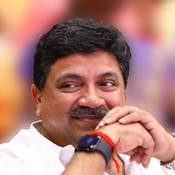

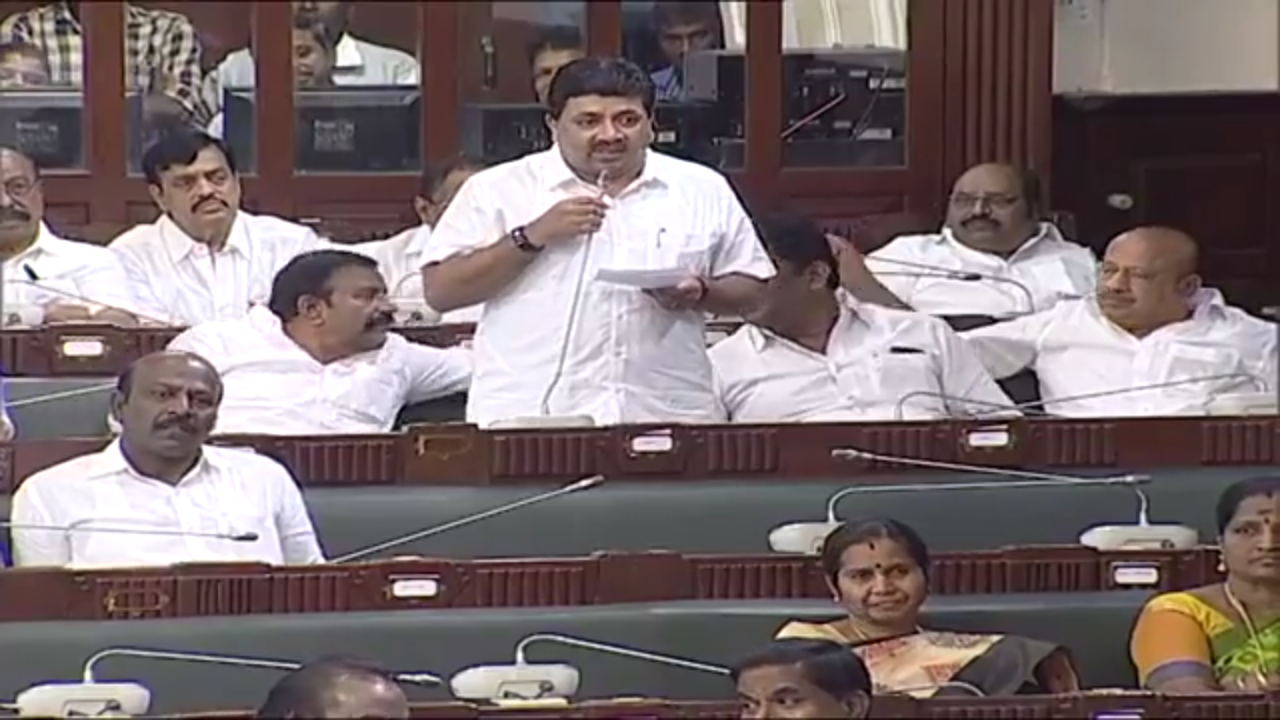
Published Date: February 17, 2020
Hon’ble Speaker, as I rise to initiate the debate on the Annual Budget for the FY 2020-2021 delivered by the Hon’ble Finance Minister, I thank my leader, the opposition leader of this house, and the leader in whom the people of Tamil Nadu vest great hope, for giving me this opportunity. I thank you also, for affording me this chance.
On a personal note, I pay my respects to my Mother, who is in the visitor’s gallery today – and who has returned to this house after more than 20 years, a period when my own father PTR Palanivel Rajan graced the majestic chair you now occupy, as the leader of this August chamber.
I am reminded of what a great privilege it is to address this historically important house, and the elected representatives who collectively represent the roughly 8 crore Tamil people. In addition to the important roles that such chambers bear in any Democracy, this chamber has the additional glory of hosting the first Dravidian legislators almost 100 years ago.
Therefore, for anyone speaking in THIS house, a certain decorum, as well as clarity of intent is called for. There are places to talk politics; to relish the cut & thrust of partisan debates. But in this house, one most focus their comments upon improving the impact of laws and schemes, including the State’s budget plans, to enhance their benefit to the people alone.
Of course, it has hard to find taller leaders than Arignar Anna, or Thalaivar Kalaignar, as far as parliamentary debate is concerned, not just when considering Tamil Nadu, or even India, but indeed the whole world!
During my maiden speech in 2016, I humbly requested the late then Chief Minister, that tall leaders should make their remarks with one eye on posterity; that is, to serve as a guide for future generations to come, rather than current circumstances alone.
But even a simple MLA like myself must tailor his comments to his intended audience. The great luxury of our age is that there are many channels through which almost anyone can get their voice heard by the Tamil People – print media, Television, and Social Media. So I am, at times, going to utilize this great opportunity to address – through the English Media Channels - the country at large, and in particular the Central Government, and the 15th Finance Commission (which is still in service through an extension of its normal tenure). However, to ensure that my comments are more understandable by all irrespective of whether I’m speaking in Tamil or English, I have brought copies of my statements, in both English & Tamil, to be distributed to anyone who would like a copy.
Hon’ble Speaker, I only get one opportunity a year to participate in a debate (since the Assembly meets for only about 30 days a year), and hence I would like this opportunity to raise 4 (repeated) requests of the Hon’ble Chief Minister and the Govt.:
1) As I mentioned during my Maiden Speech, there can be no long-term solution to the traffic congestion in Madurai (a city with over 2000 years of recorded history) without a Metro system, as part of a traffic and urban Master plan. I urge the Govt. to initiate, as soon as possible, at least a Master Plan initiative.
2) A comprehensive new Underground Drainage System has been in deployment for many years now under the AMRUT scheme and has had many temporary setbacks including contract cancellations & contractor blacklisting. I request the Hon’ble Minister for Local Administration to ensure the expedited completion of this long-delayed project.
3) The planned expansion of Madurai Airport has been pending for many years due to delays in the Land Acquisition, which is a responsibility of our Tamil Nadu Government. I have raised this in the house on multiple occasions in the past 4 years. However, the urgency has been intensified because the DCGA’s temporary exemption for operating larger aircraft is set to expire shortly and will cause great disruption to even the current travel volume should that unfortunate event come to pass. I urge the Hon’ble Minister for Transportation, and the Hon’ble Revenue Minister (who represents a Constituency in Madurai District) to work jointly to ensure the land acquisition is completed this year itself.
4) As I, and all members of the Public Accounts Committee cutting across all parties have remarked during many committee meetings in various Districts, it is distressing to note that even in the absence of elected Local Representatives over the past 4 years, all schemes under the Smart City Program, across all cities in our State, have been undertaken without any input or representation from the MLA’s or MP’s of the respective Constituencies. Without such input, we often find that schemes are selected or prioritized in less than optimal ways – relative to the people’s actual needs. I urge the Government to reform the procedures and norms for the prioritization, selection, and design of projects under this scheme – to ensure that the relevant MLA’s & MP’s are engaged in the process, even after the Local Body elections are conducted.
Hon’ble speaker, as I have done in past years, I am also submitting for the kind attention of the Hon’ble Finance Minister, through your office, some analysis & comments I have made publicly outside this house. I trust he will find the useful should he choose to address some of these points during his response, as he has kindly done in previous years.
Now to the Budget itself. I have only a few important points to ask the Hon’ble Finance Minister, and these are all based on official statistics released by his own Department, the Reserve Bank of India, the CAG’s office, or some other function of the Government of India, such as the Niti Aayog. Should the Hon’ble Minister feel at any point that the numbers I have used, or calculated, are somehow incorrect, I am happy to stand corrected with better information than is currently accessible to me.
And as a constructive Opposition Member, I would also like to highlight some of the positive aspects I’ve noted in this Budget, after raising the issues I would like clarified.
The Hon’ble Finance Minister is first to be commended for his Herculean, and possibly record-breaking effort, of reading the Budget for over 3 hours continuously on Friday. At the outset, he commented that many had predicted this Govt would not last it’s full term, and how such people have seen their hopes dashed. It is true, this Govt has lasted beyond the expectations of many, including myself. And I congratulate the entire Govt for this.
But at the same time, I must point out that we have lived in an extraordinary, “abnormal” period for the past few years – and this surprise is only one of the many surprises, and even shocks, this period has produced. For example, many assumed that the poor economic record of the Central Govt would ensure they were not re-elected in 2019, but were surprised when it happened. No one expected to see a months-long, and continuing, lockdown of Kashmir. And no one expected to see the widespread & ongoing protests against the Central Govt.’s CAA/NRC/NPR plan – which is somewhat reminiscent of the Jallikattu protests but spread throughout the country and for a more sustained period. More importantly, over 2,05,66,082 Tamils across Tamil Nadu have come out in support for the signature campaign undertaken by our Hon’ble leader Thiru M.K.Stalin, against the implementation of CAA/NRC/NPR. In other words, over 25% of all of Tamil Nadu or one third of the total voters in Tamil Nadu have supported the cause undertaken by the DMK.
More to the point, no one could have assumed that the State of Tamil Nadu’s Finances would reach the dire straits we find ourselves at today. As one measure, the total debt is predicted to reach almost 4.60 lakh Crores by the end of this year, or roughly Rs. 57,800 for every person in Tamil Nadu, Adults & Minors included.
It is clear to me how we got here – because I have been cautioning against this very outcome, at every opportunity for the past 4 years. I repeat what I stated earlier – our fundamental problem is that Revenues, as a % of GSDP have slid dramatically. For the benefit of Members, I want to clarify that whenever we compare performance across time, or States, or Countries, Nominal Amount (i.e. Rupees or Dollars) are not a reliable measure – primarily because the purchasing power of all currency (as well as the exchange rates) are changing all the time. Inflation reduces the purchasing power of Rupees, and hence makes comparisons across many years meaningless.
The right way to compare performance across time, or states, is as a proportion of the Economic activity of that time & place - % of Gross State Domestic Product (GSDP, at a State Level) or Gross Domestic Product (GDP, at a National Level) as the case may be. And while on the methodology of comparisons, I want to state that any and all comparisons of performance must be separated by the year 2003 – the year that the India Parliament passed the Fiscal Responsibility in Budget Management Act (FRBM), and the Tamil Nadu Legislature passed our own Financial Responsibility Act (FRA). As far as Govt Finances in India are concerned the periods before and after 2003 should be separated into two different ERAs as we do BCE and CE. Comparing performance across 2 different eras – is equivalent to comparing actions before a law governing the action is instituted, and after the law is implemented. I would have thought this fact was self-evident, but the Hon’ble Minister’s response last year didn’t seem to factor in this fundamental logic, unfortunately.
So, as I have stated many times before (starting during the 2017 Budget Debate), our Govt’s revenues have dropped by around 3.5% to 4% of our GSDP.
|
Avg Annual Income Generated |
KK ('06-''11) |
JJ ('11 to '16) |
EPS ('16 to '19) |
EPS ('16 - '21) Estimate |
|
Revenue/GSDP |
14.34% |
12.84% |
10.37% |
10.37% |
|
State's Own Revenue/GSDP |
10.46% |
9.62% |
7.20% |
7.20% |
|
Central Grants & Taxes/GSDP |
3.88% |
3.22% |
3.17% |
3.17% |
The same truth, from a different perspective, can be found in this excerpt from the CAG’s Audit Report for the 2017 – 2018 Financial Year.

The CAG itself points out that the 14th Finance Commission projected Tamil Nadu’s State’s own tax revenues for 2017 -2018 at Rs. 1,46,893 Crores – the number it used (among others) as the basis to determine our share of Central Taxes. However, the final account for the year shows the corresponding actual revenue was only Rs. 93,737 Crores – a shortfall of Rs. 53,156 Crores, or 36.19% lower than projected! I humbly make the point that our Nominal GSDP for the year ending March 2018 was 14,45,227 Crores, and that 53,156 Crores is 3.7% of that number (within the 3.5% to 4% I stated in 2017 itself)!
I take neither pride, nor joy, in this validation. Instead, I worry that this Govt is not open to advice, and perhaps doesn’t want to admit problems exist. The extreme example of such blinkered behavior is our Union Govt, which after having brought about a demand-induced slowdown in our country for the first time since Independence, goes about weakening its balance sheet by providing one supply-side concession after another, or tax reductions to relatively affluent people – when it should instead be trying to get funds into the hands of the least affluent segments of society. I urge the Finance Minister to not follow a similar path of living in denial, and instead to address this serious problem squarely at least now.
Hon’ble Speaker, the next point I want to take up is the distinction between non-discretionary, or compulsory, expenses of a Govt, and discretionary, or policy-based expenses incurred by the Govt. As we all know, many of the Government’s expenses are non-discretionary - like pensions, salaries, basic maintenance (non-wage Operations & Maintenance or O&M) and Interest expenses - are legally required to be paid and the consequences of defaulting on any of these payments are very severe. These costs always increase year over year, partly due to inflation, partly due to the increase in debt (that all governments undertake) and partly due to statutory compliance with Pay Commissions.
The unfortunate combination of declining revenue and increasing non-discretionary expenses leaves the Govt with much less flexibility in terms of enhancing discretionary expenses like welfare measures and schemes. However, in a Democracy no government will take the political risk of lowering the overall expenditure on welfare schemes and subsidies to the people. Consequently, even the discretionary spending is constantly increasing. Taken all together this is a recipe for incurring ever-increasing revenue deficits which has been the case for the last few years – starting in 2014 and accelerating from 2016 onwards.
The table shows the Revenue Deficit realized each of the last few years:
|
2014 |
2015 |
2016 |
2017 |
2018 |
2019 |
2020 RE |
2021 BE |
|
|
Revenue Deficit |
1,788 |
6,407 |
11,985 |
12,964 |
21,594 |
23,459 |
25,072 |
21,618 |
|
% of GSDP |
-0.22% |
-0.59% |
-0.99% |
-0.97% |
-1.49% |
-1.41% |
-1.35% |
-1.03% |
You will notice of course that the Revised Estimate for the current year, and the Budget estimate for the upcoming year, show improvements (at least as a % of GSDP). But the Hon’ble Minister will pardon me if I say that I do not put much stock in such a good outcome. I say that based on the track record of the past few years with respect to forecasting, execution, and final account closing. Please refer to the tables below:
|
Year |
BE |
RE |
FA |
RE - BE |
FA - RE |
FA - BE |
|
2018 |
15,930 |
18,370 |
21,594 |
15% |
18% |
36% |
|
2019 |
17,491 |
19,300 |
23,459 |
10% |
22% |
34% |
|
2020 |
14,315 |
25,072 |
NA |
75% |
?? |
?? |
Given such large variations occur between estimates and outcomes, perhaps you will understand why I am reluctant to believe that we will see any actual improvement in this or the coming year. In any case, the question arises – why does the performance deteriorate so much AFTER the budget estimate is complete? In my humble opinion, it is the result of multiple last-minute “unplanned” expenses introduced after the budget, through the use of questionable “Rule 110” of the Assembly’s Book of Procedures, and then funded through the use of Supplemental Budgets (like the ~7,000 Crore introduced and passed in January this year). I will explain the basis for this position with specific data points later. For now, it is my unpleasant duty to point out the following reality:
|
Revenue Deficit |
All-India Rank |
Explanation |
|
|
2017-18 |
21,593.88 |
# 1 |
Indisputable CHAMPION based on final accounts of all states |
|
2018-19 |
23,459.44 |
#1 or #2 |
Rajasthan Final Account not yet available - can't decide Champion |
|
2019-20(RE) |
25,071.63 |
#1, #2, or #3 |
Many States Revised Estimates not released yet |
As my party leader, this House’s Opposition Leader, said during the debate on the Governor’s Address last month, we are perplexed by how this kind of financial performance leads to a “Best Administration” Award…but we have no dispute with your #1 Title here!
The subsequent problems that follow this kind of Financial profligacy are manifold – and explained in the foundation textbooks on Macro-Economics:
1) Reduced ability to increase spending on the welfare of the people (beyond Non-Discretionary expenses)
No Government start its Policies or Accounts from scratch. Rather it inherits, and then adapts/corrects/enhances the Fiscal & Policy legacy of the Govt that preceded its own term. In that sense, every Govt starts with the “Baseline” left by the previous Government, and then tries to do better in its own way. With that understanding, it easy to see how the “Falling Revenue (% of GSDP)” & “Increasing Non-Discretionary Expenses” have squeezed this Govt’s ability to meaningfully ramp up spending on Social Welfare Schemes, as the table below shows:
|
Expense Growth (Year over Year) |
KK ('06-''11) |
JJ ('11 to '16) |
EPS ('16 to '19) |
EPS ('16 - '21) Estimate |
|
Welfare (Discretionary) Spending |
21.0% |
19.4% |
9.7% |
9.8% |
|
Increase in Spending – Full Term |
KK ('06-''11) |
JJ ('11 to '16) |
EPS ('16 to '19) |
EPS ('16 - '21) Estimate |
|
Welfare (Discretionary) Spending |
Rs. 1 - Rs. 2.59 |
Rs. 1 - Rs. 2.42 |
Rs. 1 - Rs. 1.36 |
Rs. 1 - Rs. 1.59 |
2) The need to BORROW on the Revenue Account, even to do the meagre improvements in Discretionary/Welfare spending that one can undertake
In fact, even to do the meagre increase in spending, the Govt is forced to use Current (or Revenue) Account borrowings as the following table shows:
|
How was Enhanced Welfare Financed? |
KK ('06-''11) |
JJ ('11 to '16) |
EPS ('16 to '19) |
EPS ('16 - '21) Estimate |
|
Baseline Welfare Spending (Rs. Crore) |
9,398.40 |
24,365.72 |
59,061.72 |
59,061.72 |
|
INCREASE in Wefare Spending (Rs. Crore) |
41,882.49 |
96,193.90 |
31,552.12 |
95,016.10 |
|
Total Increase (% from Start) |
159% |
142% |
32% |
59% |
|
INCREASE as a % of Final Year's GSDP |
8.08% |
7.93% |
1.90% |
4.54% |
|
Amount Financed by Revenue Def. (Rs. Crore) |
Nil (Surplus) |
17,056.80 |
31,552.12 |
95,016.10 |
|
So % Financed From Current Revenues |
100% |
82% |
0% |
0% |
|
% Financed by raising Debt |
0% |
18% |
100% |
100% |
|
Total |
100% |
100% |
100% |
100% |
Given this scenario, I point out that all new “gifts” announced after 2016, like the Rs. 1,000 per family for Pongal, are financed ENTIRELY by Revenue Deficits (additional borrowings), and hence add to the debt liability of future generations (our children)
3) Rapid Increase in Non-productive Borrowing, leading to a “crowding-out” effect with respect to borrowing for Investments, due to the Fiscal Deficit Cap under FRA (2003)
|
What was Borrowing Used For ? |
KK ('06-''11) |
JJ ('11 to '16) |
EPS (16 to 19) |
EPS ('16 - '21) Estimate |
|
Total Increase in Debt (Rs. Crore) |
44,655.31 |
114,182.88 |
139,715.08 |
240,531.07 |
|
Borrowing Used for Interest Payments |
- |
- |
26,465.35 |
9,690.64 |
|
Borrowing Used for INCREASED Welfare |
- |
17,056.80 |
31,552.12 |
95,016.10 |
|
Borrowing Used for Capital Investment |
44,655.31 |
97,126.08 |
81,697.61 |
135,824.33 |
|
So % used for Interest Payments |
0% |
0% |
19% |
4% |
|
% used for INCREASED Welfare |
0% |
15% |
23% |
40% |
|
% used for Capital Investment |
100% |
85% |
58% |
56% |
4) Leading to a Rapid Increase in Debt & Interest Payments
|
Debt & Interest Growth Rate (YoY) |
KK ('06-''11) |
JJ ('11 to '16) |
EPS ('16 to '19) |
EPS ('16 - '21) Estimate |
|
State's Debt |
12.22% |
16.22% |
18.1% |
17.0% |
|
Interest Payments |
13.0% |
16.7% |
17.4% |
15.4% |
5) Requiring a SIMULTANEOUS slowdown in the rate of Investment Growth
|
Growth (Year over Year) |
KK ('06-''11) |
JJ ('11 to '16) |
EPS ('16 to '19) |
EPS ('16 - '21) Estimate |
|
Investments |
27.1% |
23.1% |
5.0% |
12.8% |
6) And finally, in Growth itself, as a function of lower Investments (as a % of GSDP)
|
Avg Annual Surplus/Deficit |
KK ('06-''11) |
JJ ('11 to '16) |
EPS ('16 to '19) |
EPS ('16 - '21) Estimate |
|
Fiscal Deficit/GSDP |
-2.18% |
-2.62% |
-3.31% |
-3.12% |
|
- Revenue Deficit (+Surplus)/GSDP |
0.32% |
-0.26% |
-1.31% |
-1.25% |
|
= Investments/GSDP |
2.50% |
2.36% |
2.00% |
1.87% |
|
Economic Growth (Nominal) |
KK ('06-''11) |
JJ ('11 to '16) |
EPS ('16 to '19) |
EPS ('16 - '21) Estimate |
|
GSDP |
17.2% |
18.5% |
11.1% |
11.5% |
7) And the Consequent deterioration in the basic performance metric of the FRA (2003) – The Debt/GDP Ratio, and the derived Interest/State’s Own Revenue & Interest / Overall Revenue statistics – effective dismantling of the intent of the Act itself
|
FRA ('03) Goals |
KK ('06-''11) |
JJ ('11 to '16) |
EPS ('16 to '19) |
EPS ('16 - '21) Estimate |
|
Debt/GDP |
24.44% to 19.66% |
19.66% to 17.82% |
17.82% to 21.38% |
17.82% to 21.83% |
|
Interest/Rev |
14.75% to 11.68% |
11.68% to 14.08% |
14.08% to 16.90% |
14.08% to 16.92 |
|
Interest/SoR |
17.78% to 16.04% |
16.04% to 20.32% |
20.32% to 24.52% |
20.32% to 24.84% |
These combined actions have left every Tamilian with the debt of Rs. 57, 500 on his/her head – including our children!
|
Estimate (Popl. not exact) |
End of 2011 |
End of 2016 |
End of 2019 |
End of 2021 |
|
Total Debt |
1.02 Lakh Crore |
2.16 Lakh Crore |
3.59 Lakh Crore |
4.57 Lakh Crore |
|
Per-Capita Debt |
Rs. 14,000 |
Rs. 29,825 |
Rs. 45,000 |
Rs. 57,500 |
Now, I expect that the Hon’ble Finance Minister & his team will try to paint me as alarmist or as indulging in partisan attacks. So, as before, I support my case with the views of two “Neutral Parties” – the Reserve Bank of India (through its Annual State of State Finances Report), and later, the 15th Finance Commission (XVFC).
The following charts show that our State has largely under-performed our fellow Southern States – in complete contrast to a few years ago, when we used to lead the way:
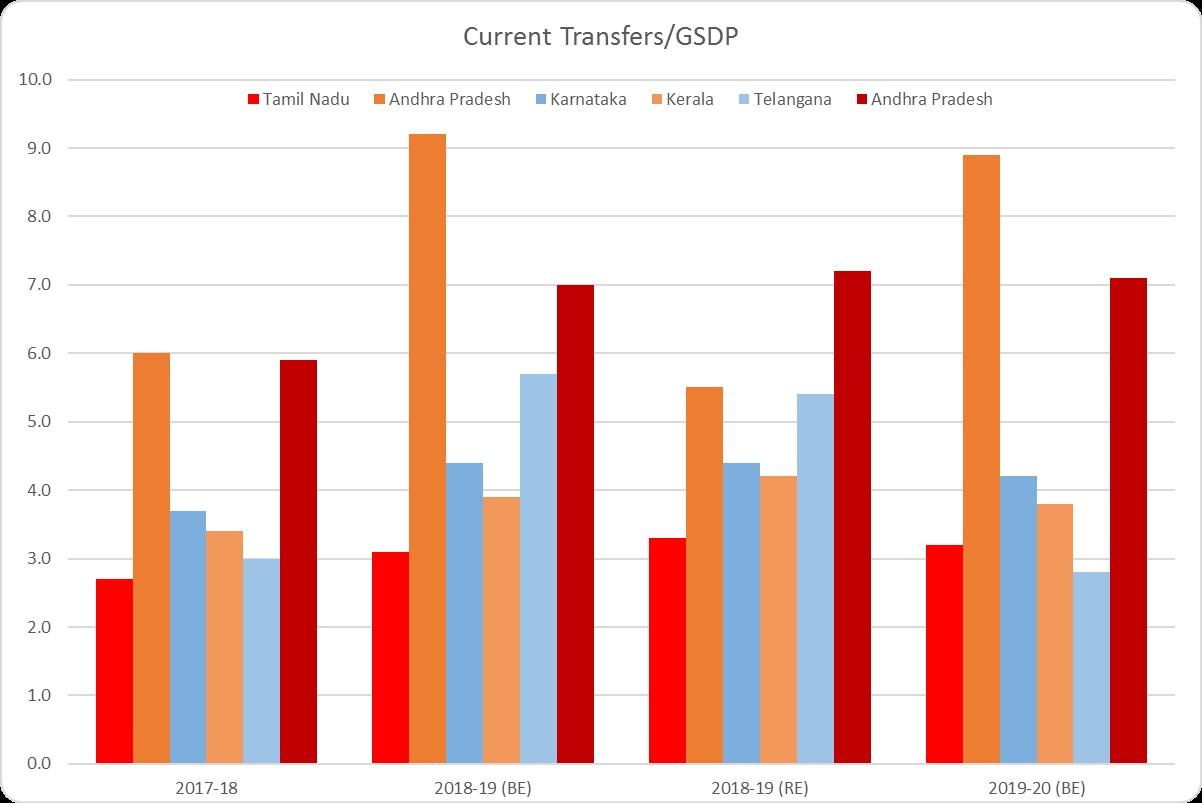
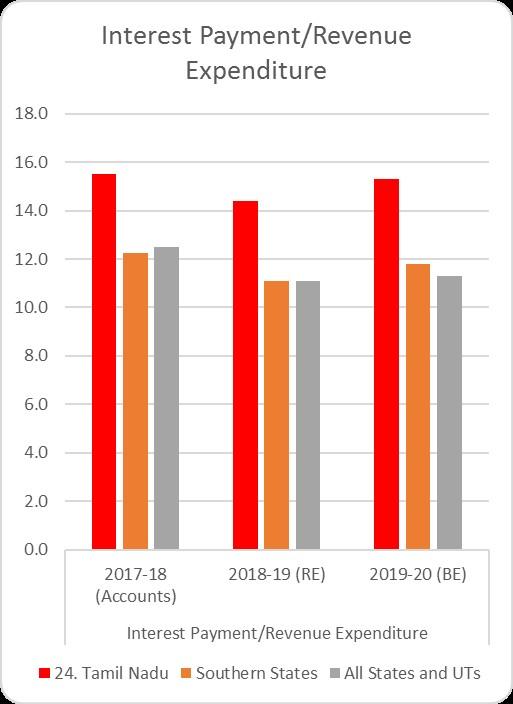
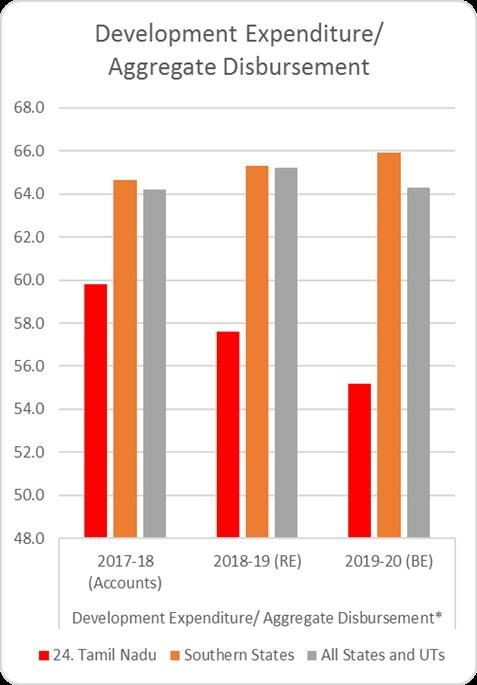
This house will agree that this Union Govt has already subjected the States to many betrayals, and one of the unkindest cuts may be the callous and biased way it has directed the functioning of the XVFC. When States like ours, who had aggressively reduced Population Growth through various measures, protested the inclusion of 2011 Census Population Data (alone), and the dropping of the 1971 Population Data (as had been used in previous FCs) in the Commission’s original Terms of Reference (ToR) issued by the Union Finance Ministry, the then Finance Minister Mr. Jaitley refused to entertain (as far back as 2018) our requests to modify the XVFC’s ToR. YET, in August 2019, with barely 60 days to go the end of the XVFC’s original time period (set to expire in Oct 2019), this same Finance Ministry not only amended the ToR to its liking, but EXTENDED the life of the XVFC – not once, but twice (all the way to October 2020)!
To add insult to injury, the interim report of the XVFC, submitted to the Union Finance Minister at the end of January 2020, claims to use a factor called “Demographic Performance” - which was allegedly introduced to offset the punitive consequences to States which had controlled their populations effectively, but which on analysis appears to be highly POSITIVELY correlated with population (as opposed to negatively correlated to provide true relief as promised).
|
Year |
Tamil Nadu Allocation |
|
|
10th |
1994 |
6.637% |
|
11th |
1999 |
5.385% |
|
12th |
2004 |
5.305% |
|
13th |
2009 |
4.969% |
|
14th |
2014 |
4.023% |
|
15th (Interim) |
2019 |
4.190% |
While there are many other issues with this XVFC outcome from various perspectives, I want to point out that our own Financial Management has been so poor recently (after 2014) that – for the FIRST TIME IN OVER 25 YEARS – the recommendation allocation of taxes for our State has been marginally increased!
Meanwhile the allocation for all the other 4 Southern States (Andhra, Kerala, Karnataka & Telangana) has been CUT! In other words, we have left the company of our neighbours as far as financial performance is concerned, and reached the company of States like Bihar, Madhya Pradesh, Uttarakhand & Jharkhand!
There can be no greater accolade than this for the Financial Performance of our State over the past 5 years – from parity with Karnataka, to parity with Madhya Pradesh & Uttarakhand! That has more information value than all the “Governance/Administration” Awards distributed by the Union Govt and the India Today Media Group, combined!!
|
14th FC Share |
15th FC Share |
Change |
|
|
Karnataka |
4.71 |
3.65 |
-24.75% |
|
Kerala |
2.5 |
1.94 |
-23.81% |
|
Telangana |
2.43 |
2.13 |
-14.71% |
|
Assam |
3.31 |
3.13 |
-7.91% |
|
Andhra Pradesh |
4.31 |
4.11 |
-6.63% |
|
Haryana |
1.1 |
1.08 |
-4.35% |
|
Odisha |
4.64 |
4.63 |
-2.56% |
|
Uttar Pradesh |
17.95 |
17.93 |
-2.52% |
|
West Bengal |
7.33 |
7.52 |
0.00% |
|
Goa |
0.38 |
0.39 |
0.00% |
|
Bihar |
9.67 |
10.06 |
1.72% |
|
Tamil Nadu |
4.02 |
4.19 |
1.78% |
|
Madhya Pradesh |
7.55 |
7.89 |
1.89% |
|
Uttarakhand |
1.05 |
1.1 |
2.27% |
|
Jharkhand |
3.14 |
3.31 |
3.03% |
As I mentioned earlier, Hon’ble Speaker, I will conclude my speech with a few positive comments and accolades about this Budget and the Finance Ministry.
First, I commend the Govt’s initiative to establish the Centre for Public Finance at the Madras School of Economics. It is a needed and timely initiative, which I am sure will prove of great value to future administrations when made functional.
More importantly, I applaud the IFHRMS e-Governance initiative, and hope that it will provide the basis for the much-needed structural reforms in Government functions that are crucial to progress, in my humble opinion.
I await the report from, and the implementation of, the recommendations of the Expenditure Rationalisation Committee, led by Thiru S. Audiseshiah IAS (Retd.) - which I hope will provide a noticeable boost in the efficiency of the Govt’s functioning.
While applauding the move to increase funding for the Adi Dravidar & Tribal Welfare, as well as the Welfare of BC, MBC & DC Departments, I make a request on behalf of our Public Accounts Committee Chairman & Deputy Leader of the Opposition, Annan Duraimurugan, as well as my fellow committee members from both sides of the aisle, such as Hon’ble Members TRB Rajaa, Udhayasuriyan, DGP Natraj, Dr. V.P.B. Paramasivam, Dusi Mohan, P.V. Bharathi, & Kunnam Ramachandran, – that both the concerned departments, as well as the Local Audit function of the Finance Dept. must increase their review and audits of the functioning of the many hostels run by these departments across the State. They are a crucial element towards achieving the Dravidian Movement’s goal of enhancing Social Justice – and I very disappointed to say that most of the hostels the PAC has visited while on tour need a huge amount of improvement just to meet basic norms.
One last point, Hon’ble Speaker. The MTFP table at the end of this year’s Budget book contains a curious feature. In almost all measures, from Revenue to Expenditures, the projections for the next 2 years ’21-’22 and ’22-’23 show an ANNUAL growth rate of ~14% year-over-year. At first, I found this puzzling, since the track record for these measures over the last 5 years has ranged between 7% & 10% or so - so why is the Finance Ministry expecting the performance to suddenly jump to 14%?
Then I realized – it is a function of how our Finance Department is trying to improve forecasting. They have clearly made those estimates in anticipation of the new Government that will be in place for those years – headed by our party leader, and the future Chief Minister, Thiru M. K. Stalin!
Hon’ble Speaker, I thank you, and my leader, once again for the opportunity, and all the respected members of this House, in whose company I am privileged to be, for their time and attention!
Vanakkam!